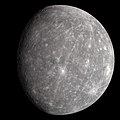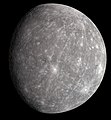File:Mercury in true color.jpg

Kukura kwe chipandwa ichi: 600 × 600 pixels Zvimwe misimbiro: 240 × 240 pixels | 480 × 480 pixels | 768 × 768 pixels | 1,040 × 1,040 pixels
Fayera repachivambo (1,040 × 1,040 pixels, file size: 408 KB, MIME type: image/jpeg)
Nhoroondo ye fayera
Dzvanya pa musi/nguva kuti uringe fayera sekuoneka kwaraita panguva iyoyo.
| Musi/Nguva | Mfananoudoko | Mitandu | Mushandisi | Komenda | |
|---|---|---|---|---|---|
| parizvino | 08:16, 15 Chivabvu 2023 |  | 1,040 × 1,040 (408 KB) | CactiStaccingCrane | Reverted to version as of 10:42, 24 July 2022 (UTC) |
| 08:01, 15 Chivabvu 2023 |  | 1,024 × 1,024 (837 KB) | CactiStaccingCrane | Manually merge the original monochrome image with the calibrated color image to eek out more resolution | |
| 10:42, 24 Chikunguru 2022 |  | 1,040 × 1,040 (408 KB) | JCP-JohnCarlo | Make this planet image center | |
| 10:25, 24 Chikunguru 2022 |  | 1,040 × 1,040 (710 KB) | JCP-JohnCarlo | Canvas image | |
| 09:00, 3 Mbudzi 2019 |  | 960 × 1,040 (865 KB) | Mirecki | User created page with UploadWizard |
Kushandiswa kwe fayera
There are no pages that use this file.
Kushandiswa kwe fayera pasirose
Mawiki anotevera ayo anoshandisa fayera iri:
- Hushandiso pa af.wikipedia.org
- Hushandiso pa als.wikipedia.org
- Hushandiso pa ar.wikibooks.org
- Hushandiso pa as.wikipedia.org
- Hushandiso pa be-tarask.wikipedia.org
- Hushandiso pa beta.wikiversity.org
- Hushandiso pa bn.wikibooks.org
- Hushandiso pa bo.wikipedia.org
- Hushandiso pa br.wikipedia.org
- Hushandiso pa ceb.wikipedia.org
- Hushandiso pa ckb.wiktionary.org
- Hushandiso pa csb.wikipedia.org
- Hushandiso pa cv.wikipedia.org
- Hushandiso pa cy.wikipedia.org
- Hushandiso pa de.wikipedia.org
- Hushandiso pa dty.wikipedia.org
- Hushandiso pa dz.wikipedia.org
- Hushandiso pa eml.wikipedia.org
- Hushandiso pa en.wikipedia.org
- Mercury (planet)
- Terrestrial planet
- The Planets
- Timeline of discovery of Solar System planets and their moons
- List of Solar System objects by size
- List of gravitationally rounded objects of the Solar System
- User:Kwamikagami/sandbox
- NASA
- User:Kazkaskazkasako/Books/Physical sciences
- Talk:Mercury (planet)/Archive 3
- User:Nrco0e/Userboxes
- User:Applekle/sandbox
- Wikipedia:Userboxes/Location/Extraterrestrial
- Talk:The Planets/GA1
- User:Double sharp/Largest Solar System objects
- User:TomMasterReal
- User:Nrco0e/Userboxes/FavMercury
- User:KeroseneLover100/sandbox/sandbox
- Hushandiso pa en.wikibooks.org
- Hushandiso pa en.wiktionary.org
- Hushandiso pa eo.wikipedia.org
- Hushandiso pa es.wikipedia.org
Ringa kushandiswa kumwe kwe vupasirose kwe fayera rino.

